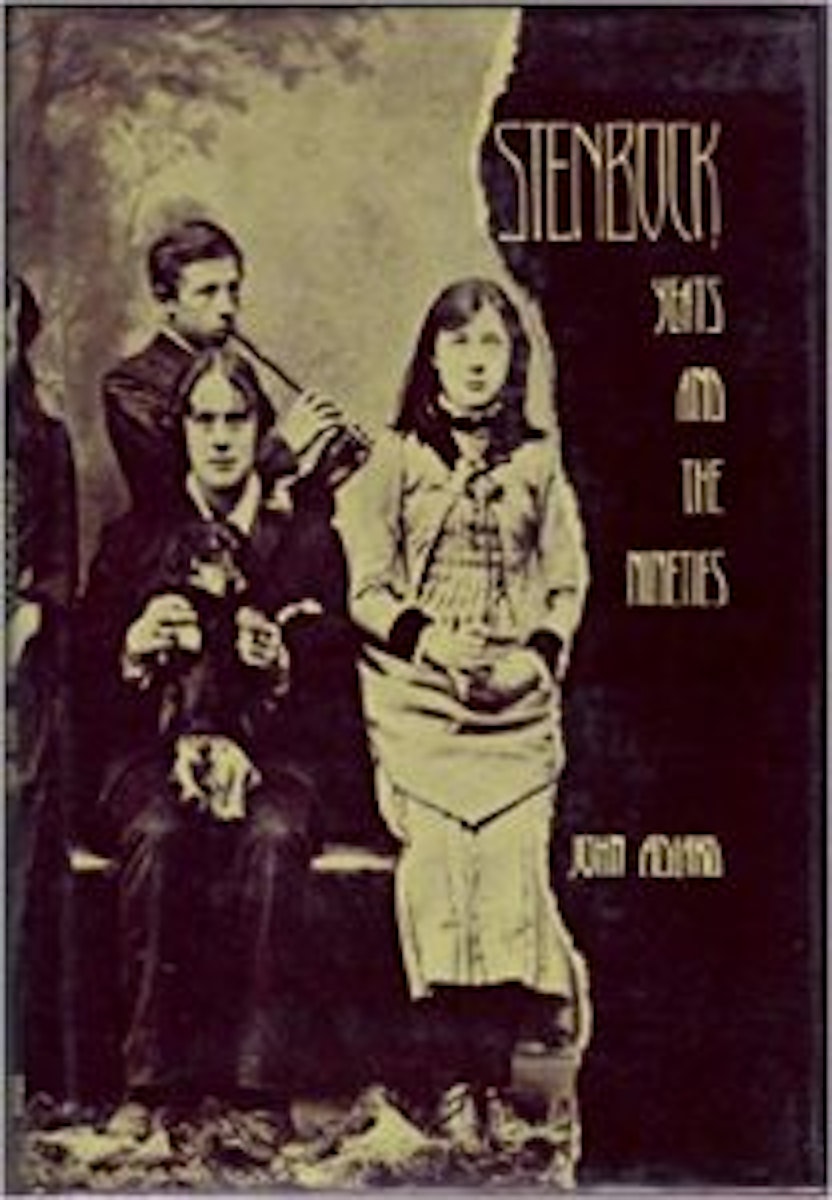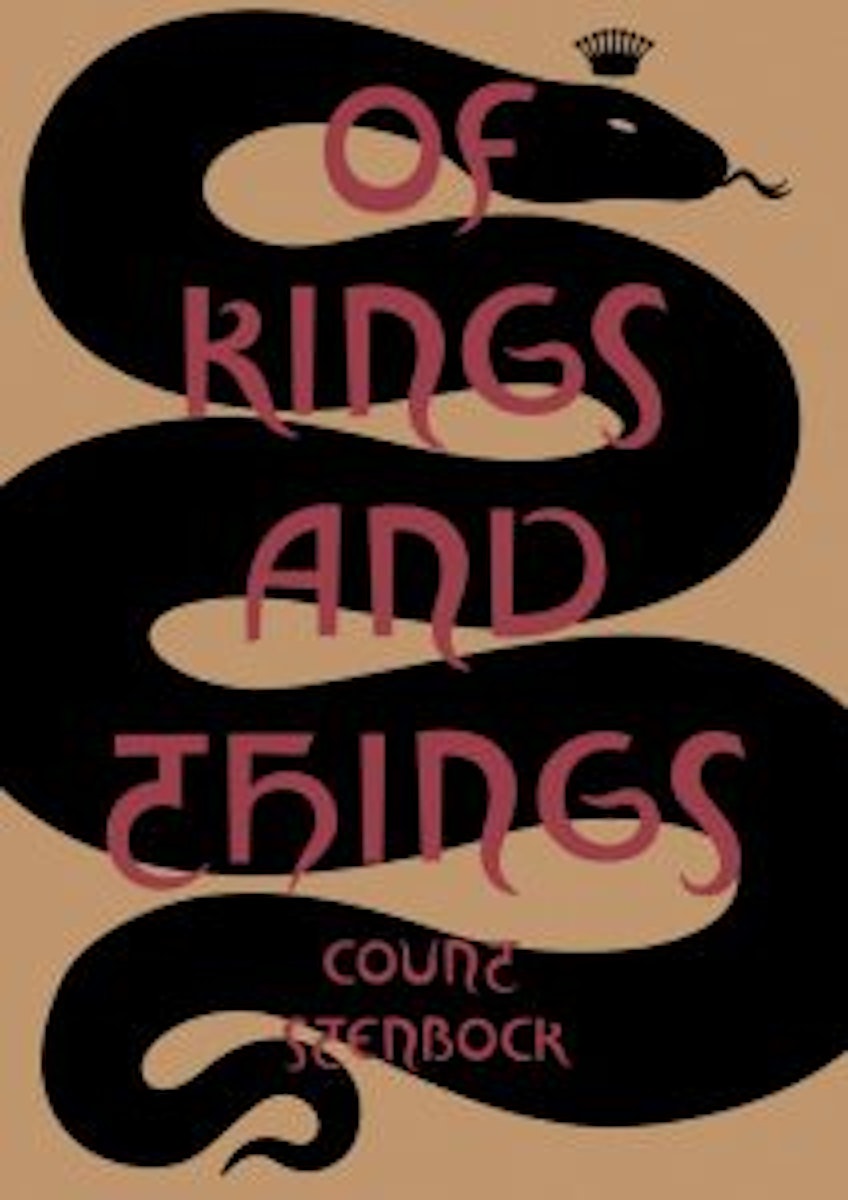
Eric, Count Stenbock A Catch Of A Ghost
With his extravagant dress, entourage of exotic pets, and morbid fascinations, Count Stenbock is considered one of the greatest exemplars of the Decadent movement. David Tibet on the enigmatic writer’s short and curious life.
September 12, 2018
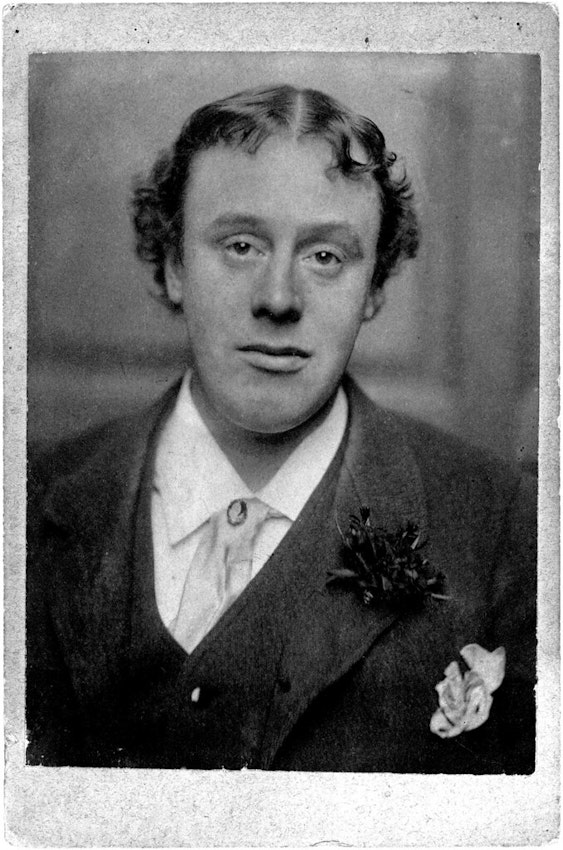 Scroll through the whole page to download all images before printing.
Scroll through the whole page to download all images before printing.Stenbock photographed in St Petersburg by Frederick Hollyer, 1886 — Source.
In his lurid and excitable The Magical World of Aleister Crowley (1977), the popular historian of magic Francis King wrote of Count Eric Stanislaus Stenbock that
[he] made an attempt to understand his own homosexuality in terms of traditional occultism, eventually coming to view his condition as an aspect of vampirism and lycanthropy. . . torn between Catholicism and diabolism. . . he died, deluded that a huge doll was his son and heir, in 1895.
This fantastical portrait of a decadent and his doom is as much as even the most dedicated enthusiast of baroque fiction might have known at that time about Stenbock, a deeply mysterious writer described by W. B. Yeats, in his anthology The Oxford Book of Modern Verse, 1892-1935, as a “scholar, connoisseur, drunkard, poet, pervert, most charming of men”.
Eric was born, on March 12, 1860, to Lucy Sophia Stenbock, the daughter of a well-to-do German cotton importer who had moved to England, and her husband Erik Friedrich Diedrich Magnus Stenbock, a member of the extended Swedish and Russian aristocracy, with large estates in Estonia, having the beautiful manor house at Kolga (known in German as Kolk) as the family seat.
He was christened Eric Magnus Andreas Harry, and brought up at Thirlestaine Hall in Cheltenham. His father was not to live long, dying (from drink, it is said) the following year at his estate in the Tyrol, whilst his wife was in England. Lucy soon remarried a gentleman called Frank Mowatt, a clerk in the British government’s Treasury Office; he was to become Permanent Secretary in 1894.
Information about Eric’s life is often scanty. But we do know that his health was poor as a child. The young boy entered a school in Wiesbaden, Germany in 1874, as desired by his stepfather. Leaving Wiesbaden in 1877, he went up to Balliol College at Oxford University, but he remained there for only four terms.
In a letter from March 27, 1877, Mowatt wrote to Nikolai Stenbock:
Eric has, as you know, become a Roman Catholic. It is a very great grief to his mother and myself and will I am sure cause sorrow to all his family. He is however still young, and perhaps at Kolk, where there are very few priests, he may grow wiser as he gets older, and again join some less ridiculous religion. Eric’s health until the last few years has been not good, and it has made his education very difficult. He is now however quite well and strong as you will find when he comes to you.
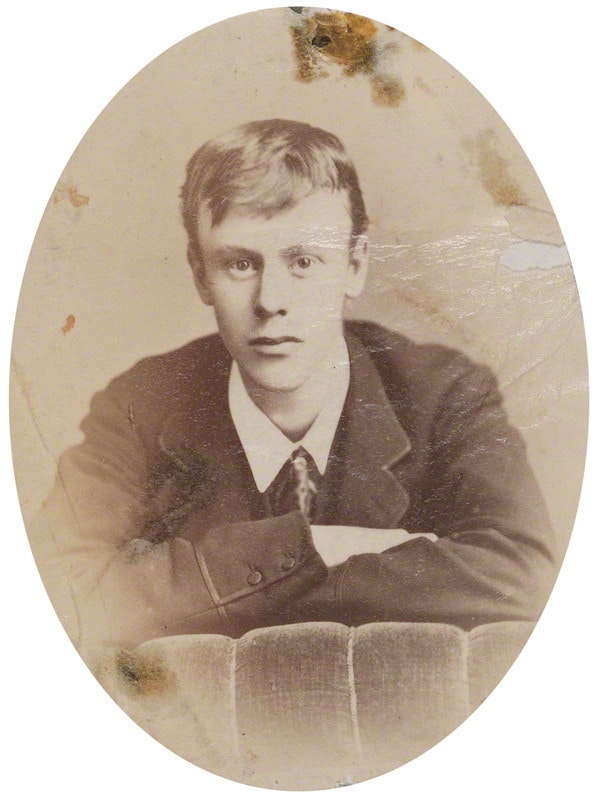 Scroll through the whole page to download all images before printing.
Scroll through the whole page to download all images before printing.A teenage Stenbock, circa 1875 — Source.
The problem was not just Eric’s conversion to the “ridiculous religion” of Roman Catholicism (at which he had taken the name Stanislaus, in honour of one of his favourite saints, St Stanislaus Kostka). Frank Mowatt foresaw future problems that would arise from Eric’s idiosyncratic and profligate nature:
I strongly recommend that he should not be allowed to spend too much money. I will supply him with an allowance of £400 a year which ought while he remains with you to be sufficient for his entire expenditure including the amount which he will have to pay to his tutor and professors. If he is allowed to spend more money or to get into debt I am afraid from my knowledge of his character that he will easily become extravagant.
In 1881, at age twenty-one, Eric published his first book, Love, Sleep, & Dreams, a short collection of haunting, melancholic, and tortured poems, including an untitled piece about a “passionate male heart” that loved the subject of the poem when he “was a boy”. No reviews of the book are known; the book itself, like all of the other volumes of his work published during his lifetime, is exceptionally rare.
Two years later, he was to publish Myrtle, Rue, And Cypress, a somewhat longer collection. He dedicated it to the extraordinary pre-Raphaelite painter Simeon Solomon, who had been arrested ten years earlier for homosexual activity in a public toilet, and who had begun his long and sad journey into public opprobrium and alcoholism. It was also dedicated to one of Eric’s cousins, Arvid Stenbock, with whom he had had a close relationship — one close enough to be looked on disapprovingly by his family — and also to Charles Bertram Fowler, the sixteen-year-old son of an Oxfordshire clergyman, who had died of consumption in 1880. The contents of the poems are desolate, suicidal, spectral and supernatural, and Eric’s love of young men is increasingly evident, as is the darkness that surrounded him. Once more, no reviews are known.
After spending time travelling in Russia, Germany, and Estonia, in 1884 Eric exiled himself to Belgium, to escape the debts he had amassed with his printers, and perhaps also through the luxurious life foretold by his stepfather. He lived in financial hardship, primarily in Bruges, until 1885, when his grandfather died and Eric inherited the palatial family estates in Estonia. He moved swiftly into the manor house at Kolga, the Stenbock residence. He was to be a generous, and much-loved, master of his lands. It was, however, already obvious that he was unlikely to marry and have children.
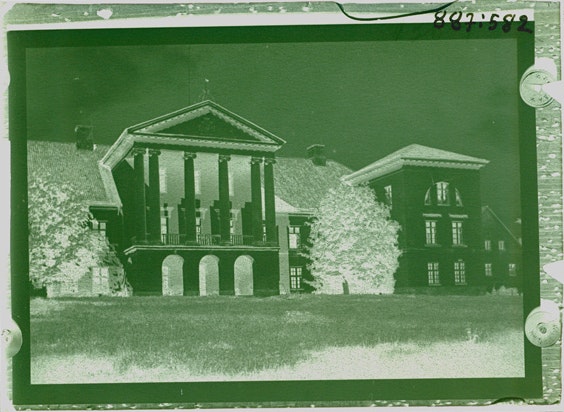 Scroll through the whole page to download all images before printing.
Scroll through the whole page to download all images before printing.Kolga Manor as pictured in 1937, from the Eesti Rahva Muuseum — Source.
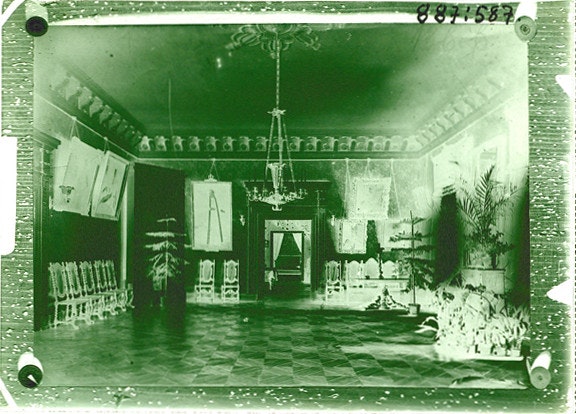 Scroll through the whole page to download all images before printing.
Scroll through the whole page to download all images before printing.Kolga Manor as pictured in 1937, from the Eesti Rahva Muuseum — Source.
Theophile von Bodisco, the daughter of Eric’s aunt Adele von Wistinghausen, lived at Kolga as a child when Eric arrived. In her fascinating Versunkene Welten (Sunken World), she recounts Eric’s arrival, and her impressions of him.
My first impression was that he was unlike any human being I had ever seen. He seemed special because of his eyes which were a bit too narrow and the long and beautifully-coiffured curls framing his extremely slender face. His mouth was long, but beautifully drawn, his hair a reddish blond, his eyes of a light blue. His dress, too, was extraordinary, made of exquisite fabrics—it seemed slightly too comfortable, not tight-fitting—a sign of his Englishness I imagined. He seemed so extraordinary. . . Eric had his little pet monkey, which he would cradle in his arm, and his snake which he would drape like a boa around his neck, as well as his delightful tiny bear sent from St. Petersburg.
An unpublished memoir by Theophile’s sister Erika describes her cousin’s lavish and unusual living quarters.
The walls were covered in English art, mostly by the pre-Raphaelites, and it was lit by a dim red lamp, with furs covering the floor. His bedroom was even more peculiar. The walls were painted peacock-blue, there was an altar in front of the marble fireplace, covered in Indian shawls, peacock feathers and copper cups from which the sweet smell of resins rose. In the middle of the altar there was a bronze statue of Eros, the god of love, in front of which there were little lamps as used by the first Christians in the catacombs.
It was clear, however, that Eric was not drawn to live the life of an Estonian nobleman. Two years later, he returned to London, as the decadent movement began to blossom there. Eric himself was to bloom, too, but perhaps not quite in the way he had hoped.
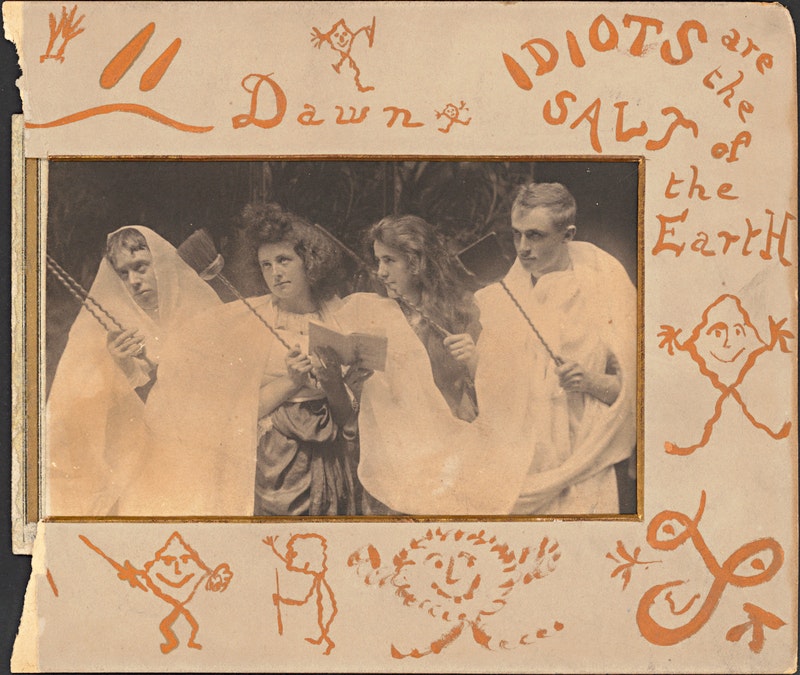 Scroll through the whole page to download all images before printing.
Scroll through the whole page to download all images before printing.The Idiot Club of London, who were dedicated to the “Suppression of Dignity and Wisdom”, photographed by Frederick Hollyer, ca. 1886. Left to Right: Stenbock, Alys Whittal Smith (first wife of Bertrand Russell), Mary Costelloe, and Logan Pearsall Smith. Stenbock also formed an “Idiot Club” for Kolk, which featured his cousin Theophile. Image from the Biblioteca Berenson, Villa I Tatti — Source.
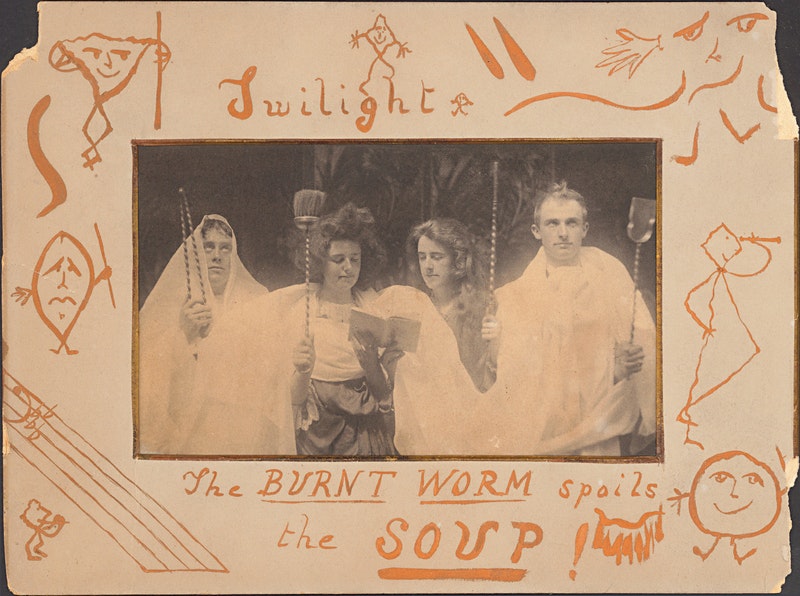 Scroll through the whole page to download all images before printing.
Scroll through the whole page to download all images before printing.Another shot of The Idiot Club of London, with a similarly decorated frame — Source.
Amongst others, he got to know Aubrey Beardsley, and purchased drawings by him, on some of which Eric wrote the titles in his own hand, and sent to a young composer, Norman O’Neill, whom he had met on a bus and whose career he was to help. There is just one account that suggests Eric was an acquaintance of Oscar Wilde, though they certainly shared many friends; it was told by the founding editor of Everyman’s Library, Ernest Rhys. Rhys had met Stenbock at a mutual friend’s salon, where he saw Stenbock enter the room:
. . .he looked most unusual: very fair hair beautifully curled, and a blond, round, blue-eyed face, with yellow eyebrows. He waved his head as he paused at the door, and took a little phial out of his pocket, from which he anointed his fingers, before passing them through his locks. He was like a magnified child; it took me a moment to believe he could be real, and there were other guests in the room who were yet more puzzled.
Rhys went on to write — and it must be noted that he had something of a reputation for inaccuracy:
whether it was. . . Stenbock’s eccentric reputation as a poet with a ‘familiar’ in the shape of a magic toad, which had inspired his curiosity, Oscar contrived, after many ineffectual attempts, to be asked one day to tea at Stenbock’s rooms in Sloane Terrace. You have heard of his upstairs sanctum with the sacred lamp burning between a bust of Shelley and a little ebony image of the Buddha. Unluckily, Oscar was an addict of the cigarette, and when he reached the room and saw the sacred red flame, his first impulse was to stalk across and light the cigarette at its ray. Stenbock, hearing of his arrival, appeared at the door just as this horrid act of desecration was committed and with a shriek, fell to the floor in a real or histrionic swoon. Whereupon Wilde stood a moment over the prostrate gure, spurned it with his foot, took two or three puffs at the accursed thing, and made his exit.
Stenbock certainly did know Arthur Symons, a decadent poet as well as a versatile man of letters. Symons suffered a terrible breakdown in 1908, from which it seems he never fully recovered. In a powerful essay entitled “A Study in the Fantastic”, Symons remembers some of Stenbock’s characteristics.
[He lived] in a bizarre, fantastic, feverish, eccentric, extravagant, morbid and perverse fashion. . . There was in him something fascinating, disconcerting. . . he was one of the most inhuman beings I have ever encountered; inhuman and abnormal; a degenerate, who had I know not how many vices. . . . He was obsessed by the immense sense of Death who might leap on him unawares, by the visions of those who, while they are supposed to lie hid in their secret sins, are scattered under a dark veil of forgetfulness, being horribly astounded, and troubled with sights. . .
Nothing of Eric’s was to be published again until 1893, when his third and final book of poems, The Shadow of Death, was published, in which he included a touching sonnet to St Stanislaus Kostka, whose name he now bore. His darkest and saddest collection, it received a withering review from The Pall Mall Gazette, who called it “an elaborate and screaming parody of that latterday literary abortion, the youthful décadent”. It goes on to say, “The slipshod versification, the maudlin sentiment, the affected preciousness, the sham mysticism and sham aestheticism, the ridiculous medley of Neo-Paganism and Neo-Catholicism, Verlaine and the Vulgate—all the nauseating characteristics of the type, in short, are here reproduced in lively burlesque.”
Eric’s only collection of short stories, Studies of Death, subtitled Romantic Tales, appeared in 1894, the year before his death, and a respectable review appeared in The Glasgow Herald. In the same year, he had submitted his strange supernatural time-slip play, La Mazurka des Revenants, to that decadent bible The Yellow Book. It was rejected by the editor, Henry Harland, “owing to the great pressure on our space”. Nothing else he wrote was to appear in his lifetime. His work, like his life, was coming to its end.
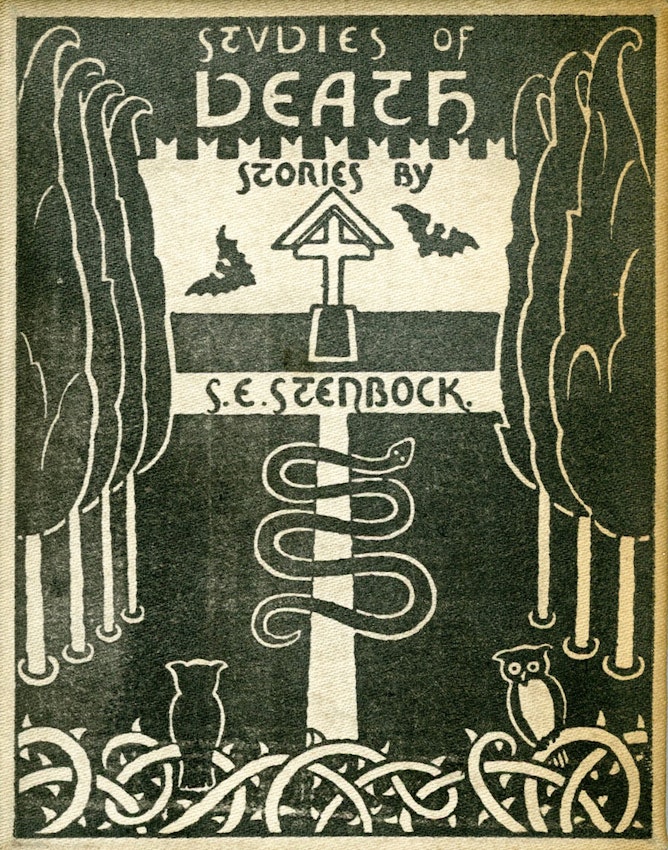 Scroll through the whole page to download all images before printing.
Scroll through the whole page to download all images before printing.Cover for Stenbock’s 1894 collection of short stories Studies of Death — Source.
W. B. Yeats based the character of Count Sobrinski, in his posthumously-published novel The Speckled Bird, on Eric, characterising him in that book as looking “half like an old man, half like a very young baby”. In an account he wrote of their dinner together shortly before Eric died, Yeats quoted Eric as saying “I have only six months to live. . . I am exceedingly dissipated, but I do not neglect my religious duties, I assure you. . . I see my confessor frequently.” Yeats observed that “Stenbock himself had been forbidden to eat anything but bread and milk, but drank limitless champagne. . . He was like a gay clever charming child, finding amid death and decay an exquisite innocence, and with the petulant angry fits of a child.”
It is from this period too that one of the strangest stories that the family told concerning Eric comes. He was said to travel everywhere with a life-sized wooden doll, whom he called “le petit comte” and whom he believed to be his son; he would send constantly for news of his “son” when he was absent. Sadly there is no other corroboration for this curious and evocative story.
One of the last accounts we have of Stenbock is given by Ernest Rhys. He visited Eric for supper, and observed; “how changed from the mercurial boyish Count Stenbock I once knew! His curly locks were gone, his lips bloodless, and there was no sparkle now in his china-blue eyes.” Not long after, Rhys was to see the count for the last time, meeting him for dinner at the famous London public house, much frequented by artists and poets, The Cheshire Cheese, on Fleet St:
He looked out of place in that old tavern, consuming stewed cheese flanked by triangles of toast and drinking old ale. Stimulated by these refreshments, he talked about a book he intended to publish, Studies of Death, and then about the inappropriate subject of death itself. ‘Death,’ said he, ‘is a dirty doorway to a wonderful region where there will be no London fogs and none of the evil that trouble the poets and artists here.’ My last impression was of him standing there on the railway platform, hat off, his flaxen curls looking almost white in the staring arc lamps of the great railway station at Kings Cross.
In a later account, he poignantly adds that Stenbock was “waving a yellow silk scarf on the platform in farewell”.
Eric died on April 26, 1895, at his home, Withdeane Hall near Brighton. It was said that, in a drunken rage, he had tried to attack someone with a fire-poker — perhaps the housemaid of whom Eric said, according to Yeats’ account of their dinner, “How I hate her, how I hate that woman.” At the family seat in Estonia, Count Michel Stenbock (to whom Eric had given Kolga after returning to London) had a vision, whilst a storm raged outside, of Eric’s face appearing at his window, weeping and in great distress. His vision was accompanied by a sense of great despair. The following morning, a telegram came to Kolga with news of Eric’s death.
On the death certificate his name is now written Eric Stanislaus Magnus Andreas Harry Stenbock. His causes of death were listed as hepatic cirrhosis, ascites (“dropsy”—a symptom commonly associated with cirrhosis of the liver), and asthenia. He was buried on May 1, “in the presence of a large number of relatives and friends”. His gravestone in the Catholic Cemetery in Brighton, East Sussex, gives his name as “Erik, Count Stenbock: (Harry)”, and the date of, and his age at, his death, “April 1895, Aged 35” below his name. It is said that his heart was extracted and sent to the church at Kusal, Estonia, where the Stenbock family’s graves are to be found.
As Oscar Wilde’s champion Robert Ross said of Stenbock’s friend Simeon Solomon after his public disgrace: “For poor Solomon, there was no place in life. Casting reality aside, he stepped back into the riotous pages of Petronius.” The same description could equally be applied to that enigmatic, and most decadent, poet and writer Count Eric Stanislaus Stenbock.
David Tibet is founder of Current 93, everyone’s favourite Hallucinatory Cuneiform SuperGroup. He has specialised in publishing Count Stenbock's work for many years, and Of Kings And Things, published by Strange Attractor, is the first mass-market edition that he has presented of Stenbock's work. His main interests are in translating Coptic and Akkadian texts, stroking his cats, and taking photographs of ghosts. Current 93's new album, The Light Is Leaving Us All, is released in October. A major exhibition of his paintings opens at The Begovich Gallery in LA in March 2019. His website is www.DavidTibet.com





